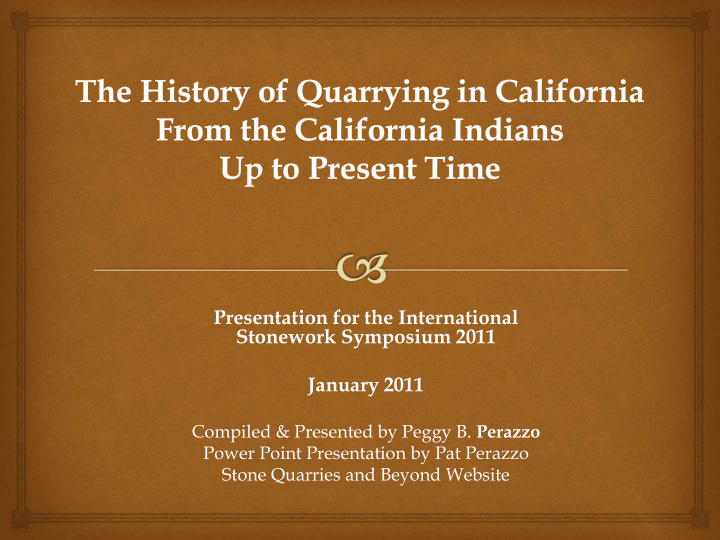



Presentation for the International Stonework Symposium 2011 January 2011 Compiled & Presented by Peggy B. Perazzo Power Point Presentation by Pat Perazzo Stone Quarries and Beyond Website
California Indians Prior to the Missions
California Indian Quarry Sites (Quarry sites shown on this map are for the following materials: Magnesite, turquoise, chrysocolla, chrysoprase, tourmaline, galena, granite, porphyry, pumice, sandstone, schist, slate, chalk, and salt.) ( Map 6, “Mines and Quarries of the Indians of California,” by Robert F. Heizer and Adan E. Treganza, California Division of Mines, Vol. 40, No. 3, July 1944, pp. 322)
Location of Tribes of California ( Map 8, “Mines and Quarries of the Indians of California,” by Robert F. Heizer and Adan E. Treganza, California Division of Mines, Vol. 40, No. 3, July 1944, pp. 322)
Map of Steatite Quarrying by California Indians (Map 2, “Mines and Quarries of the Indians of California,” by Robert F. Heizer and Adan E. Treganza, Vol. 40, No. 3, July 1944, pp. 315)
Steatite Quarrying by California Indians (Contd.) - Steatite Artifacts a , pipe , Modoc County; b , pipe , Sacramento Valley; c , pipe , Santa Barbara; d , arrowshaft straightener , San Bernardino, San Joaquin County; e , small-mouthed, thin-walled olla , Santa Barbara; f , cylindrical jar , San Joaquin County (Fig. 10., Mines and Quarries of the Indians of California , by Robert F. Heizer and Adan E. Treganza, Vol. 40, No. 3, July 1944, pp. 328)
Steatite Quarrying by California Indians Localities of Steatite Quarrying (Contd.) (“Fig . 112. Traces of aboriginal work in soapstone quarry, Santa Catalina Island. ” Handbook of Aboriginal American Antiquities: The Lithic Industries , W. H. Holmes, Bureau of American Ethnology, Bulletin 30, Part 1, 1919, pp. 239)
Quarrying and Working Steatite at the Santa Catalina Island Quarry by California Indians (“Fig. 2. “Mines and Quarries of the Indians of California,” by Robert F. Heizer and Adan E. Treganza, Vol. 40, No. 3, July 1944, pp. 325)
Quarry Site on Santa Catalina Island that local Indians used to form ollas to make globular vessels (“A California Verde Antique Quarry,” Scientific American , Vol. LXXXI, No. 25, December 16, 1899, pp. 393-394, presented on our web site.) http://quarriesandbeyond.org/states/ca/pdf_files/ca-santa_catalina_island_quarry_olla_site_1899.pdf
Steatite Quarrying by California Indians (Cont’d) Aboriginal Steatite Workings at Santa Catalina Island Quarry (Circles represent spots where globular masses were undercut at the base) (“Fig. 8A -8B. Aboriginal steatite workings at Santa Catalina Island quarry. Circles represent spots where globular masses were undercut at the base.” “Mines and Quarries of the Indians of California,” by Robert F. Heizer and Adan E. Treganza, Vol. 40, No. 3, July 1944, pp. 328)
Steatite Quarrying by California Indians (Contd.) Steatite Quarry Picks from Santa Catalina Island (Fig. 3. “Steatite Quarry Picks from Santa Catalina Island,” “Mines and Quarries of the Indians of California,” by Robert F. Heizer and Adan E. Treganza, Vol. 40, No. 3, July 1944, pp. 325)
Santa Catalina Island Road and Trail Map Map courtesy of the Santa Catalina Island Conservancy
Stone Mortars & Pestles at the Raymond Museum, Madera County On left are 2 granite mortar & pestles made by local Indians, according to Lynn Northrup, Raymond Museum. “This Indian artifact found in 1915 by Vernon Morris’ mother, Estelle, as she walked behind his father’s plow in the Knowles area at the Wilson Dairy.”
Location of Known California Indian Porphyry Source Jacumba Valley, San Diego County – “ Indians chipped off pieces of porphyry from large float boulders that occur in the Jacumba Valley. They used these pieces for large flaked blades and scrapers. (A. E. Treganza , personal observation)” 1 1. Mines and Quarries of the Indians of California , pp. 337. 2. “ Fig. 11. Chipped implements: a , ceremonial obsidian blade, Klamath River; b , chert spearpoint, Santa Barbara; c , d , e , serrated obsidian artifacts, Sacramento Count; f , hemispherical scraper of Porphyry, San Diego County.” Ibid., pp. 330.
Serpentine Quarry & Mill, Santa Catalina Island (circa 1899) (“A California Verde Antique Quarry,” Scientific American , Vol. LXXXI, No. 25, December 16, 1899, pp. 393-394, presented on our web site.)
Stone Artifacts Made by California Indians “Fig. 9G. a . Basalt mortar from Drake’s Bay shellmound; b . sandstone bowl decorated with shell beads inlaid in asphaltum, Santa Barbara; c , stone pestle , Klamath River.” Mines and Quarries of the Indians of California , by Robert F. Heizer and Adan E. Treganza, pp. 328.
Recommend
More recommend